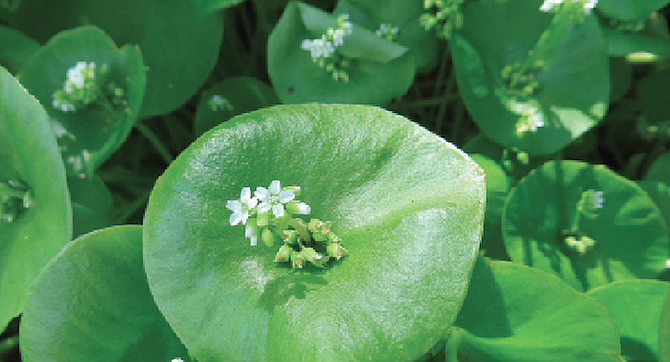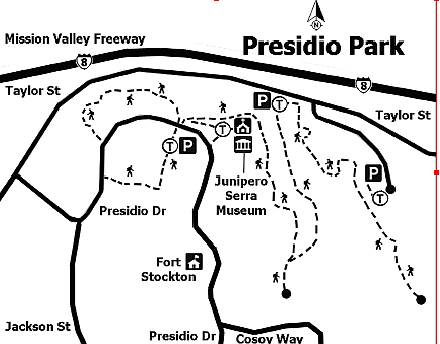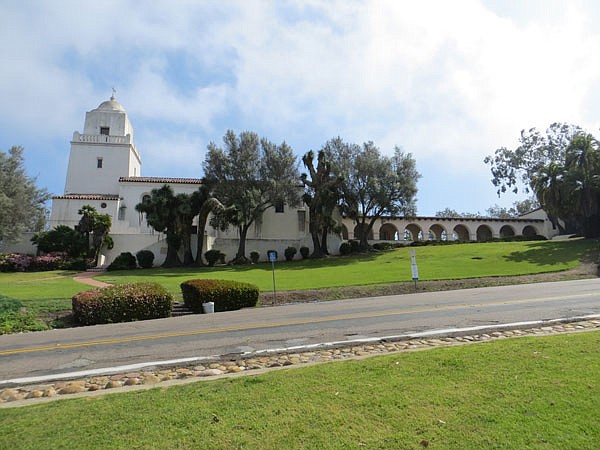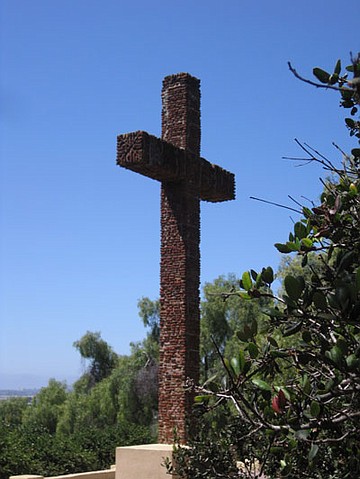 Facebook
Facebook
 X
X
 Instagram
Instagram
 TikTok
TikTok
 Youtube
Youtube

In 1769, Father Junípero Serra along with Gaspar de Portolá established the mission and presidio as the first European settlement on the Pacific Coast. There is minimal evidence of the original site just west of the parking lot that continues across Presidio Drive.

The landmark white Spanish Revival building seen atop the hill is located just east of the original site of the first mission and presidio in Alta California. George W. Marston started purchasing the land in 1907 to preserve the site and had the Junípero Serra Museum built to resemble the early missions with the purpose to exhibit the collection of the San Diego Historical Society founded in 1928.

The opening in the wall of the parking lot begins the area of the presidio where fort provisions were stored. Ahead is the Padres’ Cross constructed in 1913 with tiles from the Presidio ruins. To the left was the Padres’ quarters and chapel. To the right were the barracks for the single soldiers and the gun battery. The best view of the San Diego River and Pacific Ocean was from the married soldiers’ homes built along Mission Valley.

Close the square in the northeast across from the parking lot entrance and turn right on the sidewalk for a short walk in the shade with views of Mission Valley, I-8, and a surprising amount of native plants. Toyon, everlasting, bedstraw, lemonadeberry, and miner’s lettuce, which had the largest leaves this past March.
Miner’s lettuce (Claytonia perfoliata) is mostly found in cool, damp locations with other locations quicker to dry out as evidenced by the bright green plant turning reddish. Young growth starts out as a basal rosette, then matures to erect stems with either blade or fused circular leaves. White or pink flower clusters are either just above the leaves or on a stalk. During the California gold rush, miners ate the leaves to prevent scurvy, though it can also cause kidney stones due to it occasionally accumulating soluble oxalates. The sidewalk may be blocked off due to undermining until repaired, so do not go past any warnings; instead, retrace your steps back to the parking lot.
To explore more of the area you can walk toward the south to the area where Fort Stockton was located and beyond. There may be events to observe, such as weddings or model-plane races. Alternatively, drive back to the Presidio Drive and Taylor Street intersection and turn right to the next driveway on the right. There is only room for for or five cars here but the next driveway goes up the hill to a larger parking lot; both have access to the canyon with the cobblestone “ditch” and remnants of a picnic area.
The view from top of the Junípero Serra Museum is excellent but also of interest are pictures of the past and the layout of the presidio. For further historical information, go to sandiegohistory.org. There may be a donation requested or fee to enter the museum.
Distance from downtown San Diego: Approximately 4.5 miles. Allow 15 minutes driving time (Old Town). From I-5 N, take exit 18A onto Pacific Highway for 2.5 miles, then turn right onto Taylor Street. Drive 0.5 mile, turn right onto Presidio Drive, and follow to the left and park in the lot across from the Junípero Serra Museum.
To walk the canyon behind the museum, return to the intersection of Presidio Drive and Taylor Street and turn right for 0.3 mile where there is a small parking lot or take the next right and drive up to a larger parking lot.
Hiking Length: Total walking distance is approximately 0.6 mile for both sites out and back.
Difficulty: Easy with less than 500 feet of elevation gain/loss.
Canyoneers are San Diego Natural History Museum volunteers trained to lead interpretive nature walks that teach appreciation for the great outdoors. For a schedule of free public hikes, refer to the San Diego Natural History Museum website. Hike descriptions are also found in Coast to Cactus: The Canyoneer Trail Guide to San Diego Outdoors.


In 1769, Father Junípero Serra along with Gaspar de Portolá established the mission and presidio as the first European settlement on the Pacific Coast. There is minimal evidence of the original site just west of the parking lot that continues across Presidio Drive.

The landmark white Spanish Revival building seen atop the hill is located just east of the original site of the first mission and presidio in Alta California. George W. Marston started purchasing the land in 1907 to preserve the site and had the Junípero Serra Museum built to resemble the early missions with the purpose to exhibit the collection of the San Diego Historical Society founded in 1928.

The opening in the wall of the parking lot begins the area of the presidio where fort provisions were stored. Ahead is the Padres’ Cross constructed in 1913 with tiles from the Presidio ruins. To the left was the Padres’ quarters and chapel. To the right were the barracks for the single soldiers and the gun battery. The best view of the San Diego River and Pacific Ocean was from the married soldiers’ homes built along Mission Valley.

Close the square in the northeast across from the parking lot entrance and turn right on the sidewalk for a short walk in the shade with views of Mission Valley, I-8, and a surprising amount of native plants. Toyon, everlasting, bedstraw, lemonadeberry, and miner’s lettuce, which had the largest leaves this past March.
Miner’s lettuce (Claytonia perfoliata) is mostly found in cool, damp locations with other locations quicker to dry out as evidenced by the bright green plant turning reddish. Young growth starts out as a basal rosette, then matures to erect stems with either blade or fused circular leaves. White or pink flower clusters are either just above the leaves or on a stalk. During the California gold rush, miners ate the leaves to prevent scurvy, though it can also cause kidney stones due to it occasionally accumulating soluble oxalates. The sidewalk may be blocked off due to undermining until repaired, so do not go past any warnings; instead, retrace your steps back to the parking lot.
To explore more of the area you can walk toward the south to the area where Fort Stockton was located and beyond. There may be events to observe, such as weddings or model-plane races. Alternatively, drive back to the Presidio Drive and Taylor Street intersection and turn right to the next driveway on the right. There is only room for for or five cars here but the next driveway goes up the hill to a larger parking lot; both have access to the canyon with the cobblestone “ditch” and remnants of a picnic area.
The view from top of the Junípero Serra Museum is excellent but also of interest are pictures of the past and the layout of the presidio. For further historical information, go to sandiegohistory.org. There may be a donation requested or fee to enter the museum.
Distance from downtown San Diego: Approximately 4.5 miles. Allow 15 minutes driving time (Old Town). From I-5 N, take exit 18A onto Pacific Highway for 2.5 miles, then turn right onto Taylor Street. Drive 0.5 mile, turn right onto Presidio Drive, and follow to the left and park in the lot across from the Junípero Serra Museum.
To walk the canyon behind the museum, return to the intersection of Presidio Drive and Taylor Street and turn right for 0.3 mile where there is a small parking lot or take the next right and drive up to a larger parking lot.
Hiking Length: Total walking distance is approximately 0.6 mile for both sites out and back.
Difficulty: Easy with less than 500 feet of elevation gain/loss.
Canyoneers are San Diego Natural History Museum volunteers trained to lead interpretive nature walks that teach appreciation for the great outdoors. For a schedule of free public hikes, refer to the San Diego Natural History Museum website. Hike descriptions are also found in Coast to Cactus: The Canyoneer Trail Guide to San Diego Outdoors.
Comments